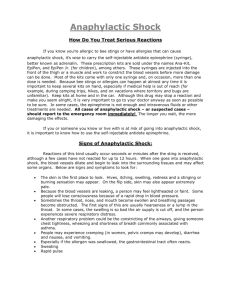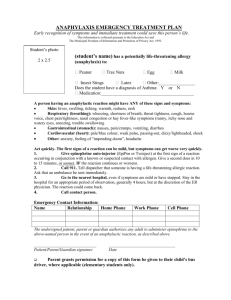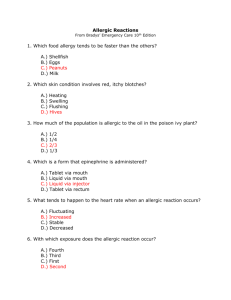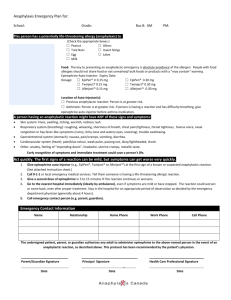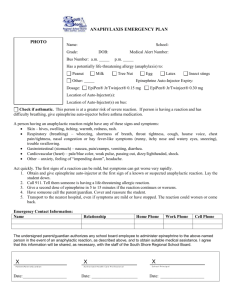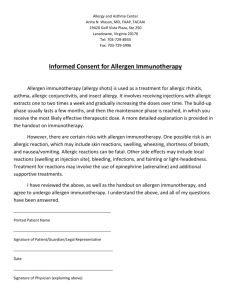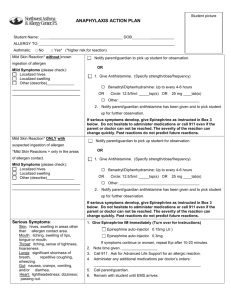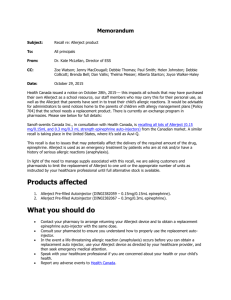Anaphylaxis
advertisement
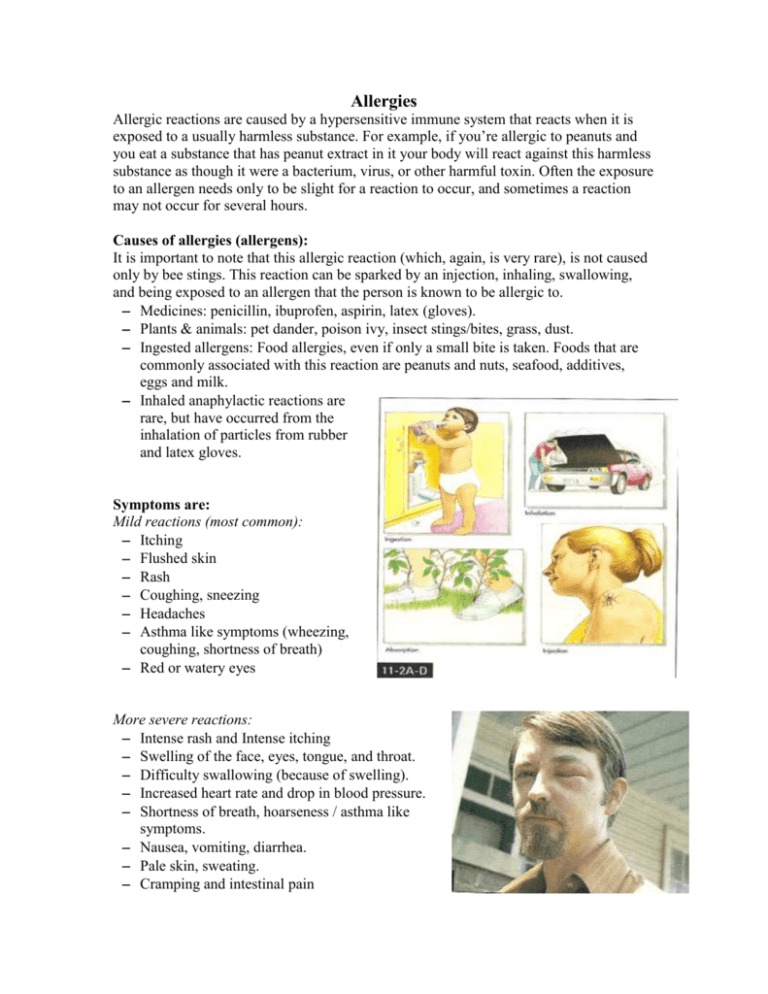
Allergies Allergic reactions are caused by a hypersensitive immune system that reacts when it is exposed to a usually harmless substance. For example, if you’re allergic to peanuts and you eat a substance that has peanut extract in it your body will react against this harmless substance as though it were a bacterium, virus, or other harmful toxin. Often the exposure to an allergen needs only to be slight for a reaction to occur, and sometimes a reaction may not occur for several hours. Causes of allergies (allergens): It is important to note that this allergic reaction (which, again, is very rare), is not caused only by bee stings. This reaction can be sparked by an injection, inhaling, swallowing, and being exposed to an allergen that the person is known to be allergic to. Medicines: penicillin, ibuprofen, aspirin, latex (gloves). Plants & animals: pet dander, poison ivy, insect stings/bites, grass, dust. Ingested allergens: Food allergies, even if only a small bite is taken. Foods that are commonly associated with this reaction are peanuts and nuts, seafood, additives, eggs and milk. Inhaled anaphylactic reactions are rare, but have occurred from the inhalation of particles from rubber and latex gloves. Symptoms are: Mild reactions (most common): Itching Flushed skin Rash Coughing, sneezing Headaches Asthma like symptoms (wheezing, coughing, shortness of breath) Red or watery eyes More severe reactions: Intense rash and Intense itching Swelling of the face, eyes, tongue, and throat. Difficulty swallowing (because of swelling). Increased heart rate and drop in blood pressure. Shortness of breath, hoarseness / asthma like symptoms. Nausea, vomiting, diarrhea. Pale skin, sweating. Cramping and intestinal pain Most Severe: Anaphylaxis or anaphylactic shock Even after being treated some symptoms may persist or reappear 8-12 hours after the initial reaction. The symptoms are usually less severe and often will go away by themselves. Some symptoms, such as the rash will appear and disappear over 4-6 hours, even if the person is no longer being exposed to the allergen. Rashes may last for several days or even weeks, so over the counter antihistamines, like Benadryl, can be used to treat it. Treatment: To prevent allergic reactions is to avoid the substances that cause the reactions. If children are left in the care of a babysitter it is important to let her know if the child has any allergies and what to do if a reaction occurs. If a reaction does occur most (mild) Can be treated with antihistamines, like Benadryl. These stop the asthma like reactions, and cold like symptoms. Those with asthma should be especially careful if they are highly allergic to a substance. If the reaction takes place on the skin (like poison ivy) use ice wrapped in a towel and hydrocortisone cream to lessen the itching and swelling. If these things don’t help, call your doctor. With plants is the cause, you should wash everything the person touched to avoid spreading it further and causing more reactions to him or other people. Wash everything, skin, hair, clothing, and toys. If you think the reaction may be due to a medication the child has taken, immediately stop treatment and contact a doctor. Even mild reactions should be treated quickly, because if they go untreated the reaction may jump from a mild to a serious reaction in a short amount of time. In more severe cases CPR and oxygen may need to be administered. For some people it is very hard to avoid the substance they are allergic to. For these people Immunotherapy, or allergy shots (small doses of the allergen that are given to the patient and increased over time in order to develop an immunity to the allergen). They are almost 100% effective but usually require at least 5 years of monthly (in some cases weekly) shots. For those who are very allergic to a substance often only a slight encounter with an allergen will send them into a potentially anaphylaxis, or anaphylactic shock. Anaphylaxis An anaphylactic reaction is characterized by swelling, especially of the face, breathing difficulty, shock, and even death. Many people with a history of anaphylaxis carry a lifesaving epinephrine auto-injector. With proper training, parents can be taught to correctly use the auto-injector to administer epinephrine to their child. Unfortunately all too often neither the victim nor family members know how to use an auto-injector correctly. First aid providers should Be familiar with the epinephrine auto-injector so that they can help someone having an anaphylactic reaction self-administer the epinephrine. be able to administer the auto-injector if the victim is unable to do so, provided that the medication has been prescribed by a physician. Anaphylactic Shock Prevention: The most important part of prevention is avoiding the allergen as best as you can. For food allergies and insect bites this may be particularly difficult as food is presented in many different ways, and insects are all around you. If the allergy involves bee stings it is important to note a few things about the bees: Honeybees can only sting you once, their stingers get stuck in the skin and they must tear away that part of their abdomen to escape. The bee dies shortly after delivering the sting. honeybees are not aggressive, like some of their relatives, wasps, and yellow jackets tend to be, these bees will only sting if they are disturbed or injured. The most common sting from these bees is when they are stepped on. The best way to avoid that is to keep shoes on while walking or playing. Bees and other stinging insects are attracted to bright colors and strong scents (perfumes). It is recommended to avoid hairspray, perfumes, and bug spray. Bug spray will not deter bees, and since the scent is strong they may even be attracted. You should also avoid areas where food is open to the environment such as garbage cans, dumps, picnic areas etc. Black is an irritant to bees, while blue is a comforting color. If a person knows that he is allergic to bee stings, it’s wise to carry the self-inject able antidote epinephrine, better known as adrenalin. These prescription kits are sold under the names Ana-Kit, EpiPen. These syringes are injected into the front of the thigh, or a muscle and work to constrict the blood vessels before more damage can be done. Most of the kits come with only one syringe and on occasion more than one dose is needed. Because bee stings can happen at almost any time during the spring, summer, and early fall it is important to keep several kits on hand, especially if medical help is out of reach, for example on vacations. The person must keep kits at home and in the car, and in case of child leave a kit with the school nurse. Although this drug may stop a reaction and make you seem alright, it is very important to go to the doctor as soon as possible to be sure. In some cases the epinephrine is not enough and intravenous fluids or other treatments are needed. ALL cases of anaphylactic shock or suspected cases should report to the emergency room immediately! The longer you wait the more damaging the effects. Signs of anaphylactic shock: Reactions of this kind usually occur seconds or minutes after the sting is received, although a few cases have not reacted for up to 12 hours. When one goes into anaphylactic shock, the blood vessels dilate and begin to leak into the surrounding tissues, which may affect some organs. signs and symptoms to look for are: The skin is the first place to look. Rashes, itching, swelling, redness and a stinging or burning sensation may appear. skin may also appear extremely pale. Because the blood vessels are leaking a person may feel lightheaded or faint. Some people will lose consciousness because of a rapid drop in blood pressure. Sometimes the throat, nose, and mouth become swollen and breathing passages become obstructed. The first signs of this are usually hoarseness or a lump in the throat. In some cases the swelling is so bad the air supply is cut off and the person experiences severe respiratory distress. Another respiratory problem could be chest tightness, wheezing and shortness of breath commonly associated with asthma. if the allergen was swallowed, the gastrointestinal tract often reacts: People may experience cramping, diarrhea and nausea and vomiting. Sweating Rapid pulse
